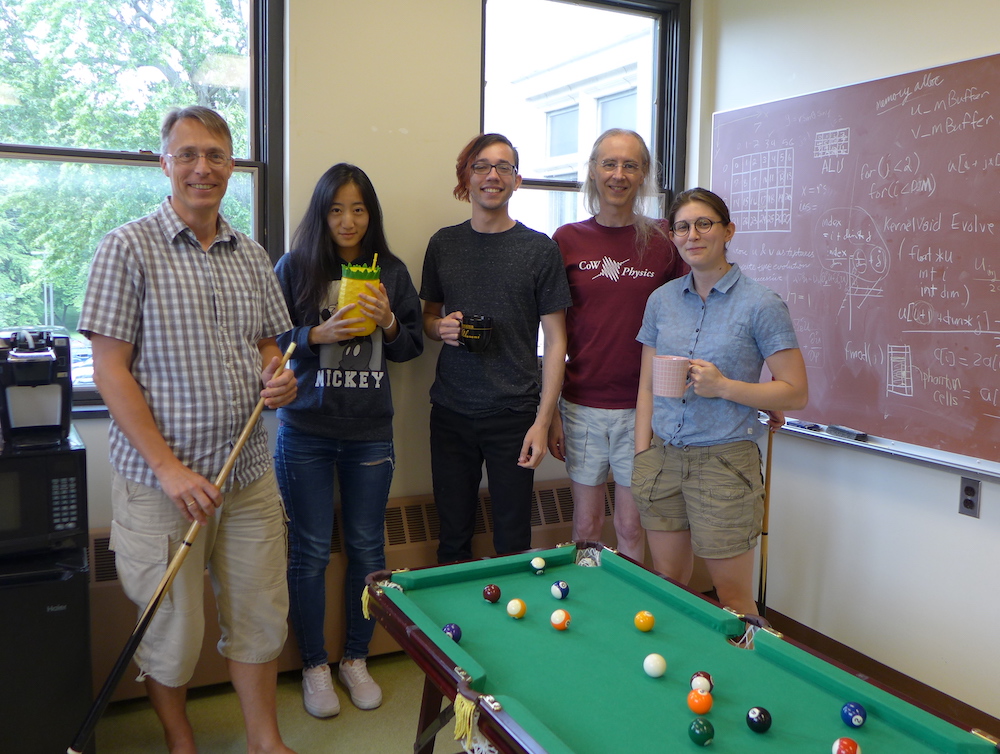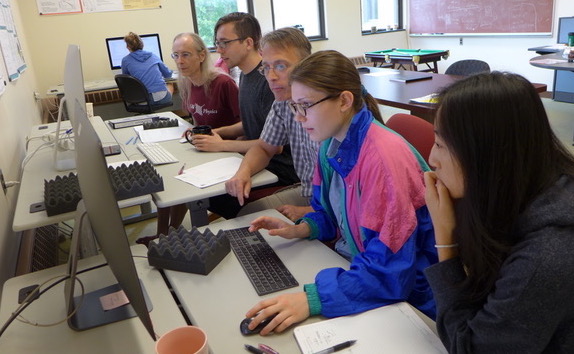Professors and students collaborate on physics publication
John Lindner, the Moore Professor of Astronomy at The College of Wooster, and Niklas Manz, assistant professor of physics, recently published an article with two Wooster undergraduates, Fish Yu ’21 and Margaret McGuire ’20, and alumnus Chase Fuller ’19, that was a result of their research in the summer of 2019. The article, “Disruption and recovery of reaction–diffusion wavefronts interacting with concave, fractal, and soft obstacles,” was published in the statistical mechanics journal Physica A and investigates how reaction-diffusion wavefronts react to concave, spiral, fractal, random, and soft obstacles.

Physics major Yu, who is the lead author on the article, explained the way that waves interact with objects. “A water wave (a straight line) continues traveling until it meets an obstacle (a stone maybe), then this line will not disappear, but will be separated into two curved lines,” she said. Reaction-diffusion systems can involve physical, biological, or chemical waves that diffuse into space after encountering obstacles. The team wrote computer simulations to study how waves would react to a variety of objects. “In our research, we let a wave travel into mazes and soft obstacles, which means the wave can go through part of the obstacles from one side but is blocked at the other side,” Yu said.
This team’s research extends the work of Reba Glaser, a graduate of The State University of New York College at Geneseo, and Nate Smith ’18 who documented how reaction-diffusion wavefronts recover after being disrupted by only hard convex obstacles. “In this work, we wrote computer simulations to study reaction-diffusion systems interacting with a wide variety of obstacles,” Lindner explained. The research was successful in identifying how wavefronts interact with obstacles of different shapes. “Our computer simulations solved many different problems, including waves navigating spiral, fractal, and disordered obstacles,” Lindner said.
Yu said that this research gave her important skills that she is now using in her senior Independent Study. “I was much more comfortable doing I.S. because of my summer research experience,” she said. “These two projects both need computational simulation, so the programming experience helped me a lot.”

The authors collaborate during summer 2019.
The professors obtained a grant from the Sherman Fairchild Foundation to fund the reaction-diffusion simulation project for the summer of 2019, and the students’ involvement in the research was also supported through the Research Experience for Undergraduates summer program funded by the National Science Foundation that Wooster offers. “Each student worked on a separate sub-project of the overall idea which we discussed often in meetings throughout the summer,” Manz said. The research team worked well together. “The weekly meeting was always exciting because we would share our results with each other and brainstorm together,” Yu said. “There were many excellent ideas and improvements that came from those meetings.”
The two professors brought their own expertise to the project. Manz leads The College of Wooster Wave Lab which studies reaction-diffusion systems and Lindner has a background in nonlinear dynamics and computer simulations.
This research did not end with this publication, as Manz mentioned another article on the group’s research has also been accepted in another peer-reviewed journal. Manz is also excited to continue to explore reaction-diffusion wavefronts beyond the use of computer simulations. “I am looking forward to creating actual experiments in the lab to replicate the behavior of chemical reaction-diffusion wave with some of those obstacles,” he said.
Above: Professors Niklas Manz (left) and John Lindner (far right) along with Fish Yu ’21, Chase Fuller ’19, and Margaret McGuire ’20 in the computational physics lab during summer 2019.
